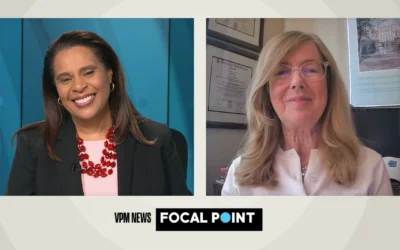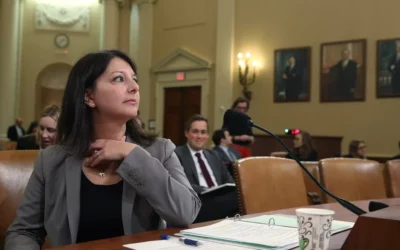WCH In the News
Is There Any Gold to Mine in the Graying of America?
Original article courtesy of Governing
by Carl Smith
November 30, 2021

Jettie Newkirk, 83, a mentor to many, has the support of a lot of young friends. She still works a bit as a lawyer. “Every day there is something new for me to be grateful for.” (Michael Bryant/Philadelphia Inquirer/TNS)
(Governing) Since peaking at 18.5 percent in 1960, the rate of U.S. population growth has declined continuously. The 2020 rate of 7.4 percent was the slowest since the 1930s; according to the former director of the United Nations Population Division, it was the second-slowest growth measured since the first government census in 1790.
In the absence of sufficient immigration, the total U.S. population is expected to decline. On the surface, this could seem to have some positive impacts, reducing environmental stresses and other unwanted consequences of overcrowding.
But long-term trends in fertility, birth rate and longevity have disrupted population balance. By 2030, one in five Americans will be 65 or older. The over-85 population is growing the fastest, and by 2050 it will comprise over 20 million people, five times its size in 2000.
The drawbacks to an aging, declining population are many. More and more people will depend on safety nets such as social security and Medicare, but the population of working people paying into them won’t grow at the same rate. Long-established patterns of earning, spending and saving will be altered, with the potential to affect fiscal sustainability and limit growth.
“We’re not reproducing an above a replacement level at the younger end of the life course, and we’re living longer at the upper end,” says demographer James Johnson Jr., distinguished professor of strategy and entrepreneurship at the University of North Carolina’s Kenan-Flagler Business School. “We are an aging population.”
Johnson, who also serves as director of the Urban Investment Strategies Center at the UNC’s Kenan Institute of Private Enterprise, studies economic development and the effects of demographic changes on the workplace. His current interests include helping gentrifying cities identify strategies for equitable and inclusive development.
Age imbalance isn’t the only way population is changing. The 2020 census revealed that the nation’s white population went down for the first time in the country’s history; between 2010 and 2020, its growth rate was 0.0 percent. By contrast, the Hispanic and Asian populations now account for more than half of population growth and are expected to triple by 2050.
The simultaneous graying and browning of America bring unprecedented challenges, but Johnson believes the right responses could overcome them, or even improve American life. The stakes are high, he says.
“If we put up barriers to the kinds of changes that need to happen to have a thriving and prosperous population and society, we’re going to lose our shirt in the global marketplace.”
In a conversation with Governing, Johnson talks about what the path forward might involve. The interview has been edited for length and clarity.
James Johnson: We can take advantage of what our demography is giving us and flip what we perceive to be a problem into a real opportunity.
Some people have been fortunate enough to do well in society. Folks retire and think they’re going to play golf every day. Then they get bored pretty quickly and want to do something else.
Many of them are hanging out shingles as “encore” entrepreneurs. They are social entrepreneurs in many instances, engaging in things like working in school systems with vulnerable children or other things that add social value.
You have the population of people who we need to provide even greater support for as encore entrepreneurs, and then there’s the 55-plus population who retired involuntarily during the pandemic. How do we bring them back into the economy? In the “great resignation” we’re going to need all five generations to get this economy back running smoothly.
It requires us to look at aging not as a problem, but a chance to tap into the most rapidly growing sectors of our population and recognize that there’s huge talent there, huge interest in working. We just have to build better training programs and business development initiatives around that population.
Governing: Are there other examples?
James Johnson: Age-friendly community development is a huge opportunity for job creation and business development. Everything has to change in society to accommodate an aging population. A pedestrian crossing signal typically assumes that the person walking across the street walks four feet per second, but the average senior walks two to three feet per second.
A lot of buildings that are built for beauty are not age friendly. It’s not about meeting guidelines for people with disabilities; it’s much bigger than that. It’s about lighting and color and things of that nature.
Designing and making communities age-friendly is not just for the senior population because the woman with the baby carriage has the same challenge as the older adult trying to cross the street. It’s about equal opportunity of access.
Governing: How is a declining population of working-age adults affecting communities?
James Johnson: The challenges of the communities that are left behind are different from the challenges of what I call “migration magnet communities.”
In the migration magnet communities, where you have large numbers of newcomers whose adjusted per capita income is higher than the people who live there, and higher than the people who are leaving, that’s a boost to the local economy.
But at the same time, you have to ask what’s the viability of the existing long-term residents as these wealthier newcomers enter. We’re increasingly seeing long-term residents priced out of these markets. House prices escalate, the cost of goods and services escalate beyond the ability of the local constituency.
What’s interesting is that the people on the short end of the stick in these places are often civil servants — police officers, fire personnel, EMS workers, public school teachers.
We have a school for vulnerable children in Durham, N.C., that a couple of years ago had four homeless teachers, all with master’s degrees.
Governing: What can be done about this?
James Johnson: Nobody’s arguing that we don’t want the wealthier newcomers. I’m making an argument that we have to impose an equity lens on development moving forward. You can’t have a civil society when your police officers can’t afford to live where they work.
There are land banks, community land trusts, and a whole range of other creative strategies for making communities more inclusive, more diverse socially and economically. It’s not that we don’t have equity tools to do this work, we just have to be more laser-like in our focus on them.
It’s a play of affordable housing — I call it workforce housing. How do we create housing for civil servants and other people who we really need, who are the glue that holds communities together?
Governing: How does zoning fit into this? Some communities are opening up single-family neighborhoods to multi-unit structures.
James Johnson: You’ve got to look at zoning in a serious way and make it more inclusive. The white population is declining; 100 percent of growth in the last decade is due to people of color, and they are far more likely to live in multigenerational households than the non-Hispanic white population.
We have to align housing policy and strategies with the realities of the demography as it shifts.
Governing: What about immigration policy? That’s set at the national level, but do states need to get involved?
James Johnson: If you’re in a place like North Carolina, in one of the 85 counties where deaths exceed births, one of the strategies you need to think about is a place-based immigration policy. We want to incentivize people to move to these communities so you can rebuild the population.
Governing: How do you promote the need to bring in people from outside the U.S. in the face of anti-immigrant sentiment?
James Johnson: You’ve got to reframe the debate. Quite frankly, I don’t think people are moved by social or moral appeals. We’ve got to talk about demographic realities.
I typically talk about competitiveness. In an innovation economy, talent is our competitive advantage. We have to have a life-course perspective on talent development — technology can’t supplant all of the demand for talent moving forward.
Governing: What about language barriers?
James Johnson: That’s got to be a two-way street. In a global society, where we’re becoming far more diverse, all of us need to be multilingual and to be able to communicate in multiple languages.
I don’t think we need to put the onus solely on immigrant newcomers to speak English.
Do you need to learn to speak English? Absolutely, but we also need to learn to speak other languages. That’s part of global citizenship. We sell a lot of products in other places. Why shouldn’t we have the facility to interact in multiple languages?
How do we fight a war on terrorism just speaking English? Can’t do it. You need a different set of skills and different set of languages to be able to do that.
Governing: What might this mean for schools?
James Johnson: Here’s my big concern on the education front: A lot of decision-makers are aging boomers and pre-boomers who really don’t have a dog in the K-12 education fight because their kids and their grandkids are out of school or attending private schools.
Our biggest challenge is getting those people to understand they do have a dog in the K-12 education fight. This is about the future competitiveness of our nation. We’re going to need wise, strong investments in the education system — which is becoming far more diverse — because that’s the next generation of talent that has to propel our nation.
Governing: What about lingering effects from the pandemic?
James Johnson: The post-pandemic cliff is going to be rooted in the mental wellness challenges that we’re going to have moving forward. I’m deeply concerned about a return-to-the-office mandate for everybody because there are clearly people for whom returning to the office is going to pose all kinds of challenges moving forward.
Some of them are demographic challenges, women with young children and still-uncertain schools, things of that nature. Fifty-one percent of the U.S. population lives in a child-care desert. How can you talk about women and the important role that they have to play in our economy moving forward without building a robust child-care infrastructure?
Governing: Any last thoughts?
James Johnson: There are competitive advantages in dealing with an aging population. Properly thought, there are opportunities to create jobs, create businesses, to improve the quality of education, to build and overcome.
Everybody talks about getting back to normality, but the new normal is what I call “certain uncertainty.” It’s not just the pandemic. It’s climate change, it’s all of the things going on around the globe that you have to deal with.
Who would have predicted the “great resignation”? That wasn’t even on the radar six months ago. Government leaders need tools in their toolkits to weather certain uncertainty.
Other News
Mass Migration: Why are people moving south?
Mass Migration: Why are people moving south?Virginia’s demographics are changing. Jeanne Milliken Bonds, public policy professor at UNC Kenan-Flagler Business School explains the shifts. Home | Publications | Mass Migration: Why are people moving south?...
The EIDC Economic Development Journal – Fall 2023
WCH In the NewsThe EIDC Economic Development Journal - Fall 2023 International Economic Development Council1275 K Street, NW, Suite 300 • Washington, DC 20005 • www.iedconline.orgChair: Jonas Peterson, CEcDPresident & CEO: Nathan OhleEditor: Jenny Murphy.November...
The painful pandemic lessons Mandy Cohen carries to the CDC
The painful pandemic lessons Mandy Cohen carries to the CDC"North Carolina initially failed to prioritize testing for people who were exposed to #COVID19 because of where they live or work." - Jeanne Milliken Bonds, Professor of Social Impact Investing at the...




